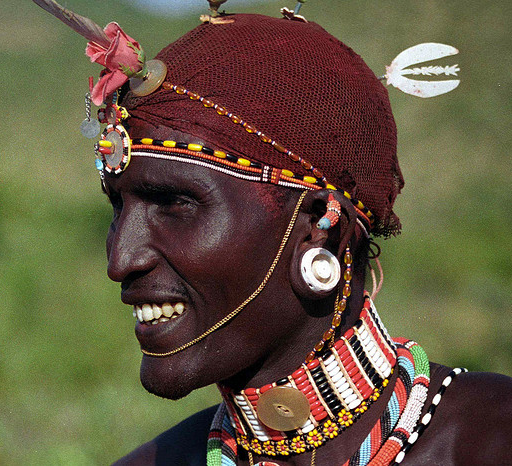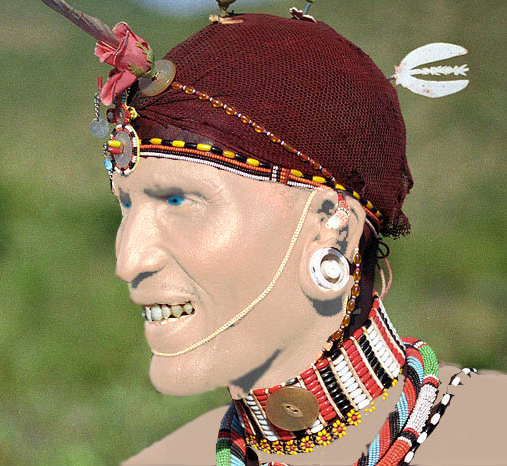

It is generally believed that black people do not possess blue eyes. The blue eyes has always been associated with the Caucasians (whites). In many scientific studies and a more recent one conducted by the Copenhagen University the genetic mystery of “blue eyes” is said to have originated from the northeast coast of the Black Sea.
Individuals with N1a have been identified in Egypt, Ethiopia, Eritrea, Somalia, Kenya, and Tanzania. In Ethiopia, 2.2% of the population was found be members of N1a, but the haplogroup was only identified in Semitic speakers. In Egypt, 0.8% of the population were found to be members of N1a. A study of Kenyans found a prevalence of N1a to be around 10% in the Rendille population, and it was around 1% in the Maasai.
The Rendille (also known as Rendille, Reendile, Rendili, Randali, Randile and Randille) are a Cushitic-speaking ethnic group inhabiting the northern Eastern Province of Kenya. The ethnonym Rendille translates as “Holders of the Stick of God”.
The Rendille are believed to have originally migrated down into the Great Lakes area from Ethiopia in the more northerly Horn region, following southward population expansions by the Oromo and later the Somali.
Traditionally, they are nomadic pastoralists, tending camels, sheep, goats and cattle. The camels are generally kept in the northern part of their territory and the cattle in the southern section.
The first ethnological study of the Rendille was published at the turn of the 20th century by William A. Chanler. It described the unmixed Rendille that his party encountered as tall, slender and reddish-brown in complexion, with soft, straight hair and narrow facial features.
Chanler additionally remarked that many of the Rendille possessed “fierce” blue eyes, a physical peculiarity that was also later noted by Augustus Henry Keane (1900), John Scott Keltie (1904) and John Henry Patterson (1909).
According to Ethnologue, there were approximately 34,700 Rendille speakers in 2006. Most are concentrated in the Kaisut Desert and Mount Marsabit in the Marsabit District of Kenya’s northern Eastern Province.
The Rendille speak the Rendille language as a mother tongue (also known as Rendile or Randile). It belongs to the Cushitic branch of the Afro-Asiatic family. Some Rendille also use English or Swahili as working languages for communication with other populations.
The Cushitic languages are a branch of the Afro-Asiatic language family spoken primarily in the Horn of Africa (Somalia, Eritrea, Djibouti, and Ethiopia), as well as the Nile Valley (Sudan and Egypt), and parts of the African Great Lakes region (Tanzania and Kenya).
The branch is named after the Biblical character Cush, who was traditionally identified as an ancestor of the speakers of these specific languages as early as 947 CE (in Masudi’s Arabic history Meadows of Gold).
The most populous Cushitic language is Oromo (including all its variations) with about 35 million speakers, followed by Somali with about 18 million speakers, and Sidamo with about 3 million speakers. Other Cushitic languages with more than one million speakers are Afar (1.5 million) and Beja (1.2 million).
Somali, one of the official languages of Somalia, is the only Cushitic language accorded official status in any country. It is also one of the recognized national languages of Djibouti, the other being Afar.
The Ariaal sub-group of the Rendille, who are of mixed Nilotic and Cushitic descent, speak the Nilo-Saharan Samburu language of the Samburu Nilotes with whom they cohabit.
Recent advances in genetic analyses have helped shed some light on the ethnogenesis of the Rendille people. Genetic genealogy, although a novel tool that uses the genes of modern populations to trace their ethnic and geographic origins, has also helped clarify the possible background of the modern Rendille.
According to an mtDNA study by Castri et al. (2008), the maternal ancestry of the contemporary Rendille consists of a mixture of Afro-Asiatic-associated lineages and Sub-Saharan haplogroups, reflecting substantial female gene flow from neighboring Sub-Saharan populations.
About 30% of the Rendille belonged to the West Eurasian haplogroups I (15%), a descendant (subclade) of haplogroup N1e’I (Behar 2012b) and sibling of haplogroup N1e (Behar 2012b) believed to have arisen somewhere in Eurasia between 17,263 and 24,451 years before present (Behar 2012b) in Iran or more generally the Near East (Terreros 2011), N1a (8%), M1a (3%) and R0/pre-HV (3%). The remaining samples carried various Sub-Saharan macro-haplogroup L sub-clades, mainly consisting of L0a (22%) and L2a (8%).
The Rendille’s autosomal DNA has been examined in a comprehensive study by Tishkoff et al. (2009) on the genetic affiliations of various populations in Africa. According to the researchers, the Rendille showed significant Afro-Asiatic affinities. They also shared some ties with neighboring Nilo-Saharan and Bantu speakers in the Great Lakes region due to considerable genetic exchanges with these communities over the past 5000 or so years.
In terms of creed, many Rendille practice a traditional religion centered on the worship of Waaq/Wakh. In the related Oromo culture, Waaq denotes the single god of the early pre-Abrahamic, montheistic faith believed to have been adhered to by Cushitic groups. Some Rendille have also adopted Islam or Christianity.
Filed under: Uncategorized
